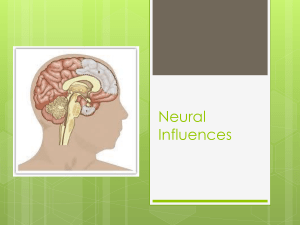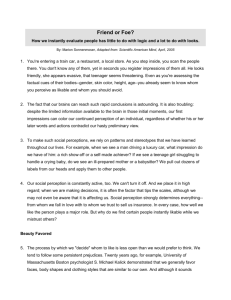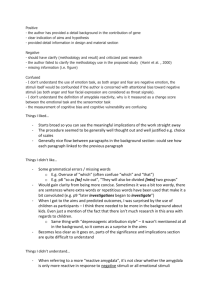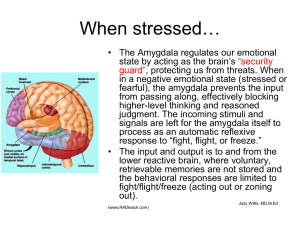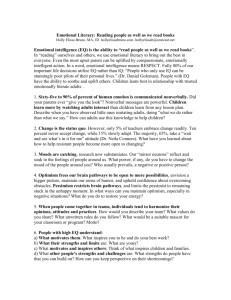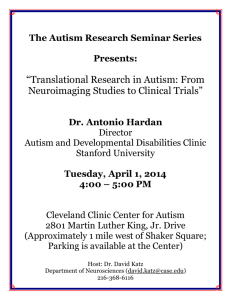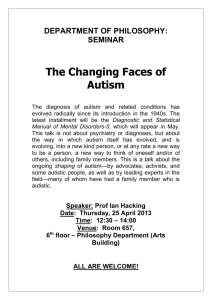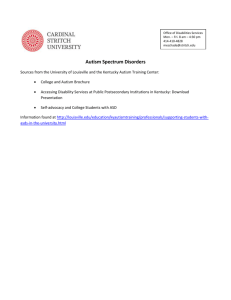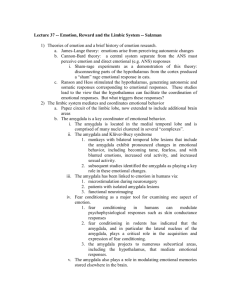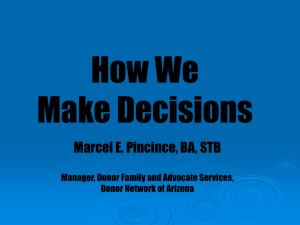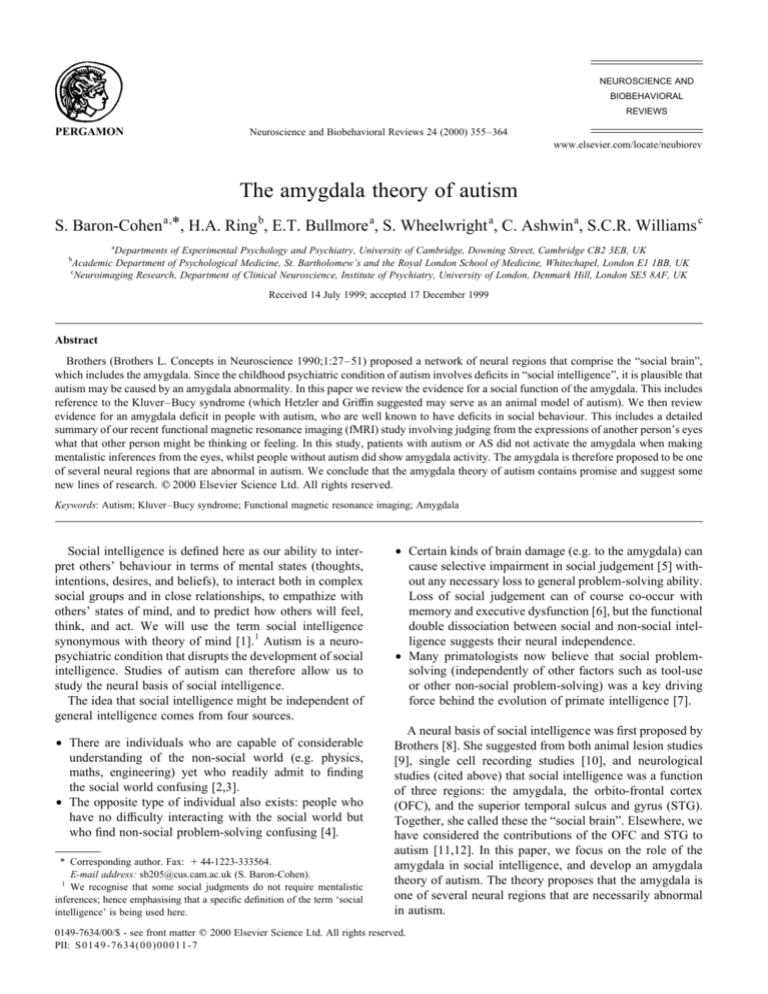
NEUROSCIENCE AND
BIOBEHAVIORAL
REVIEWS
PERGAMON
Neuroscience and Biobehavioral Reviews 24 (2000) 355–364
www.elsevier.com/locate/neubiorev
The amygdala theory of autism
S. Baron-Cohen a,*, H.A. Ring b, E.T. Bullmore a, S. Wheelwright a, C. Ashwin a, S.C.R. Williams c
a
Departments of Experimental Psychology and Psychiatry, University of Cambridge, Downing Street, Cambridge CB2 3EB, UK
Academic Department of Psychological Medicine, St. Bartholomew’s and the Royal London School of Medicine, Whitechapel, London E1 1BB, UK
c
Neuroimaging Research, Department of Clinical Neuroscience, Institute of Psychiatry, University of London, Denmark Hill, London SE5 8AF, UK
b
Received 14 July 1999; accepted 17 December 1999
Abstract
Brothers (Brothers L. Concepts in Neuroscience 1990;1:27–51) proposed a network of neural regions that comprise the “social brain”,
which includes the amygdala. Since the childhood psychiatric condition of autism involves deficits in “social intelligence”, it is plausible that
autism may be caused by an amygdala abnormality. In this paper we review the evidence for a social function of the amygdala. This includes
reference to the Kluver–Bucy syndrome (which Hetzler and Griffin suggested may serve as an animal model of autism). We then review
evidence for an amygdala deficit in people with autism, who are well known to have deficits in social behaviour. This includes a detailed
summary of our recent functional magnetic resonance imaging (fMRI) study involving judging from the expressions of another person’s eyes
what that other person might be thinking or feeling. In this study, patients with autism or AS did not activate the amygdala when making
mentalistic inferences from the eyes, whilst people without autism did show amygdala activity. The amygdala is therefore proposed to be one
of several neural regions that are abnormal in autism. We conclude that the amygdala theory of autism contains promise and suggest some
new lines of research. 䉷 2000 Elsevier Science Ltd. All rights reserved.
Keywords: Autism; Kluver–Bucy syndrome; Functional magnetic resonance imaging; Amygdala
Social intelligence is defined here as our ability to interpret others’ behaviour in terms of mental states (thoughts,
intentions, desires, and beliefs), to interact both in complex
social groups and in close relationships, to empathize with
others’ states of mind, and to predict how others will feel,
think, and act. We will use the term social intelligence
synonymous with theory of mind [1]. 1 Autism is a neuropsychiatric condition that disrupts the development of social
intelligence. Studies of autism can therefore allow us to
study the neural basis of social intelligence.
The idea that social intelligence might be independent of
general intelligence comes from four sources.
• There are individuals who are capable of considerable
understanding of the non-social world (e.g. physics,
maths, engineering) yet who readily admit to finding
the social world confusing [2,3].
• The opposite type of individual also exists: people who
have no difficulty interacting with the social world but
who find non-social problem-solving confusing [4].
* Corresponding author. Fax: ⫹ 44-1223-333564.
E-mail address: sb205@cus.cam.ac.uk (S. Baron-Cohen).
1
We recognise that some social judgments do not require mentalistic
inferences; hence emphasising that a specific definition of the term ‘social
intelligence’ is being used here.
• Certain kinds of brain damage (e.g. to the amygdala) can
cause selective impairment in social judgement [5] without any necessary loss to general problem-solving ability.
Loss of social judgement can of course co-occur with
memory and executive dysfunction [6], but the functional
double dissociation between social and non-social intelligence suggests their neural independence.
• Many primatologists now believe that social problemsolving (independently of other factors such as tool-use
or other non-social problem-solving) was a key driving
force behind the evolution of primate intelligence [7].
A neural basis of social intelligence was first proposed by
Brothers [8]. She suggested from both animal lesion studies
[9], single cell recording studies [10], and neurological
studies (cited above) that social intelligence was a function
of three regions: the amygdala, the orbito-frontal cortex
(OFC), and the superior temporal sulcus and gyrus (STG).
Together, she called these the “social brain”. Elsewhere, we
have considered the contributions of the OFC and STG to
autism [11,12]. In this paper, we focus on the role of the
amygdala in social intelligence, and develop an amygdala
theory of autism. The theory proposes that the amygdala is
one of several neural regions that are necessarily abnormal
in autism.
0149-7634/00/$ - see front matter 䉷 2000 Elsevier Science Ltd. All rights reserved.
PII: S0149-763 4(00)00011-7
356
S. Baron-Cohen et al. / Neuroscience and Biobehavioral Reviews 24 (2000) 355–364
1. The amygdala 2
The amygdala is a collection of nuclei. It lies beneath the
uncus of the temporal lobe at the anterior end of the hippocampal formation and the inferior horn of the lateral ventricle. It develops relatively early in gestation (embryonic day
30–50), but the separate nuclei do not differentiate until
postnatal life, suggesting plasticity in the cues to which the
amygdala responds [13]. The old view of the amygdala was
that it was mainly only interconnected with the hypothalamus, but evidence over the last two decades reveals the
amygdala is intricately interconnected with many brain
regions, including neocortex, basal forebrain, the “limbic
striatum” (nucleus accumbens and ventral pallidum), the
neostriatal structures (the caudate nucleus, and the putamen),
the hippocampal formation, and the claustrum [14,15]. The
amygdala blends in with the periamygdaloid cortex, a part of
the uncus. It is also adjacent to the tail of the caudate nucleus.
The amygdala does have some connections with the striatum,
but the overall pattern of its connections is described next.
1.1. Afferents to the amygdala
The amygdala receives a great deal of sensory input in a
highly processed form. Single amygdalar cells may respond
to somatosensory, visual, auditory, and all types of visceral
inputs. The afferents carrying this information reach the
amygdala by travelling in the reverse direction along the
paths followed by amygdalar efferents. Visceral inputs,
particularly olfactory inputs, are especially prominent.
Additional visceral information reaches the amygdala indirectly from the hypothalamus, setal area, orbital and insularcortex, and also by more direct routes; for example, the
parabrochial nucleus projects to the amygdala. The
temporal and anterior cingulate cortices also project to the
amygdala.
1.2. Efferents from the amygdala
Fibres leave the amygdala through two major pathways to
reach many of the same areas that send efferents to it. The
first pathway is the stria terminalis, which travels around
from the temporal lobe toward the interventricular foramen,
together with the caudate nucleus and the thalamostriate (or
terminal) vein. The second efferent is the ventral amygdalofugal pathway. These fibres pass underneath the lenticular
nucleus and spread out to the base of the brain, ending in the
septal area and the hypothalamus, in olfactory regions like
the anterior olfactory nucleus, the anterior perforated
substance, the piriform cortex, and in the orbital and anterior
cingulate cortices. Some reach the ventral striatum, which
includes the area where the putamen and the caudate
nucleus (the nucleus accumbens) fuse, as well as portions
of the striatum. The ventral striatum in turn projects to an
2
Information in this section is based on excellent reviews elsewhere
[19,95,96].
extension of the globus pallidus, the ventral pallidum,
beneath the anterior commissure. The ventral striatum and
pallidum are links in a basal ganglia circuit similar to that
involved in motor functions. Many ventral amygdalofugal
fibres reach the dorsomedial nucleus of the thalamus. Finally,
some amygdalar efferents pass directly to entorhinal cortex
and other cortical areas in the temporal lobe and beyond.
2. The amygdala nuclei
The amygdala is not a single entity, but comprises a
collection of 13 nuclei, located in the medial temporal
lobe [16]. For this reason, the amygdala is sometimes called
the amygdaloid complex. Traditional classification of the 13
nuclei are into three clusters:
• The deep nuclei (lateral, basal, accessory, basal, and
paralaminar), which have the greatest interaction with
the neocortex and hippocampal formation, and the most
connectivity with sensory processing.
• The superficial regions (medial, anterior and posterior
cortical nuclei), which are more closely associated with
olfactory regions and with the hypothalamus. These are
thought to play a role in maternal and sexual behaviour.
• Other nuclei (central, anterior amygdaloid area, amygdalohippocampal area, and intercalated nuclei). Of these,
only the central nucleus has been studied, and it appears
to influence the brainstem (e.g. by mediating the cardiovascular and respiratory responses during fear [17]).
Emery, using non-metric multidimensional scaling analysis based on macaque genus brains where the anatomical
connections are already defined, suggests slightly different
terminology for grouping these 13 nuclei into three clusters
[18]. (1) The basolateral (BL) group (the lateral, lateral
basal, mesial basal, and accessory basal nuclei). The BL
group appears to be functionally distinct too, containing
neurons responsive to faces and actions of others (Rolls,
1984; [113], 1992; [114]; Leonard et al., 1985; [10];
Brothers and Ring, 1992). These are not found in the next
two clusters of amygdala nuclei. (2) The centromedial (CM)
group (the central, medial, and cortical nuclei, and the
perimamygdaloid complex). The CM group innervates
many of the visceral and autonomic effector regions of the
brainstem, such as the parabrachial nuclei (involved in
respiratory control) and the dorsal motor nucleus (involved
in cardiovascular control). (3) The peripheral nuclei (PN)
group (cortical transition area, anterior amygdaloid area,
and amygdalo-hippocampal area).
Finally, in terms of neurochemistry, the amygdala has the
highest density of benzodiazepine/GABAa receptors in
the brain, and also has a substantial set of opiate receptors.
It contains serotinergic, dopaminergic, cholinergic and
noradrenergic cell bodies and pathways [19]. For a thorough
review of the neuroanatomy of the amygdala, the reader is
directed elsewhere [19,20].
S. Baron-Cohen et al. / Neuroscience and Biobehavioral Reviews 24 (2000) 355–364
3. Amygdalar function
As the amygdala has extensive connections with the septal
area and hypothalamus and with prefrontal cortex, it influences both drive-related behaviour and the related emotions.
In the first of these two roles, the amygdala modulates the
hypothalamus. Visceral or somatic activity that can be elicited
by stimulating the hypothalamus (such as feeding, or cardiovascular and respiratory changes) can also be elicited by
stimulating the amygdala. The role of the amygdala in
emotions has also been revealed via electrical studies. When
the animal’s amygdala is stimulated, the animal typically stops
whatever it was doing and becomes attentive. This may be
followed by defensiveness, fight, or flight. In humans the
most common emotion following amygdalar stimulation is
fear, accompanied by its autonomic manifestations (dilation
of the pupils, release of adrenalin, and increased heart rate).
Conversely, bilateral destruction of the amygdala causes a
decrease in aggression, with the result that the animals are
described as tame and placid.
4. Evidence for the importance of the amygdala in
primate social behaviour
There are several important lines of evidence implicating
the amygdala in primate social behaviour. Extensive
reviews exist elsewhere [9]. Here we summarise the main
lines of evidence.
4.1. Lesions of the primate amygdala affect social behaviour
Ibotenic acid lesions of the amygdala affect the social
behaviour of adult rhesus macaques [21]. In addition, amygdala-lesioned monkeys become socially isolated. They fail
to initiate social interactions, and they fail to respond appropriately to social gestures [9,22]. Kling and colleagues have
shown this pattern of effects in rhesus monkeys in seminatural settings (the Caribbean Regional Primate Center
on Cayo Santiago) [23], in caged vervets [24], in freeranging vervets [25], and in stumptailed macaques in different sized social groups [26]. The vervet study above showed
that when the amygdala-lesioned monkeys were released
into the wild they were unresponsive to group members,
failed to display appropriate social signals (neither affiliative nor aggressive), they withdrew from other animals, and
frequently they were killed. Those who were not killed
never re-entered their original social groups. The socioemotional deficits in amygdala lesions in infant rhesus
monkeys produce last into adulthood [27,28].
In one of the earliest studies, Brown and Shafer lesioned the
temporal cortex of a rhesus monkey and documented significant social and emotional deficits as a result [29]. This result
was extended by Kluver and Bucy who showed that large
lesions of the anterior temporal lobe (including amygdala,
hippocampal formation, and temporal cortex) produced a
syndrome which included the following symptoms: a
357
tendency to over-react to all objects, hypoemotionality and
loss of fear, hypersexuality 3 (excessive masturbation, copulation with any object, and fellatio with both same sex and
opposite sex monkeys), hyperorality (a tendency to investigate
objects with their mouths, not their hands, even if the object
was inedible), and in some (but not all) cases, an inability to
recognize objects (visual agnosia) [30]. They called this new
syndrome “psychic blindness” 4 because the monkeys would
approach animate and inanimate objects indiscriminately. 5
Most striking was the loss of fear towards the experimenters,
and a blunting of aggression.
Subsequent work showed that the amygdala was found to
be responsible for the emotional, oral, and sexual deficits
[31,32]; the temporal cortex was responsible for the visual
deficits [31,33]; and the dual lesions produced the combined
and full syndrome [34]. Aggleton and Passingham [35]
made selective radio frequency lesions of the whole amygdala, the basal and lateral nuclei, the lateral nucleus alone,
the dorsal nuclei, and the white matter that borders the
amygdala laterally and dorsally (the temporal stem). Their
results showed that only lesions of the whole amygdala
caused the complete Kluver–Bucy syndrome. Note that
the sexual aberrations are not always replicated in juvenile
monkeys with Kluver–Bucy syndrome [33].
Bachevalier lesioned either the medial temporal lobe
(including the amygdala, periamygdaloid cortex, hippocampus, entorhinal and perirhinal cortices), or the hippocampal
formation and amygdala separately [36,37]. The lesioned
animal infants were raised and paired with an age-matched
control animal. At two months, the infants with medial
temporal lobe lesions were more passive, displayed
increased temper tantrums, and initiated fewer social
contacts. At six months they interacted very little with the
control animal, and actively withdrew from all approaches
by the normal animals. The animals with medial temporal
lobe lesions also displayed emotionally expressionless faces
and showed more self-directed behaviour and motor stereotypies. Such abnormalities were still evident in adulthood.
Amygdala lesions alone produced a similar pattern of social
abnormalities, but to a lesser extent.
Rosvold et al. showed that amygdala lesions in monkeys
had a direct effect on the animal’s social status: social hierarchies were disrupted, this being due to the most dominant
animal falling in dominance following the amygdala lesion
3
Emery and Amaral (in press) [115], note that the projection from the
amygdala to the hypothalamus may be involved in the initiation of penile
erection and ejaculation, as electrical stimulation of the amygdala can cause
these (Robinson and Mishkin, 1966; [116]; 1968; [117]).
4
”Psychic blindness” may approximate as a non-human animal equivalent of “mindblindness” [97].
5
It is notworthy for the amygdala theory of autism outlined later in this
paper that the original description of young children with autism referred to
this lack of a differential response to people (animate objects) and things
(inanimate objects) [98]. The similarity between this aspect of the behaviour of the monkeys with Kluver–Bucy syndrome and children with
autism may reflect a common aetiological factor: amygdala abnormality.
358
S. Baron-Cohen et al. / Neuroscience and Biobehavioral Reviews 24 (2000) 355–364
[38]. Lesions in the amygdala of monkey mothers lead to the
mothers showing a reduction in maternal behaviours
towards her infant (suckling, cuddling, or protecting
them), with the result that amygdala-lesioned mother
monkeys are more likely to physically abuse or neglect
their infants [39–43]. Note that amygdala lesions in infant
monkeys do not disrupt the drive for attachment [44] but
they do have major effects on initiating and responding to
peer social interaction [37]. The data from non-human
primates is largely consistent with the data from human
lesion studies [45–47].
4.2. Amygdala volume and group size
There is a significant correlation between amygdala
volume and social group size (a positive correlation with
the BL group, and a negative correlation with the CM
group) [18]. This correlation remains significant even after
removing the effects of overall brain size and the rest of the
amygdala, as well as the effect of body size. This was
computed for 44 primate species, excluding humans. In
the Emery et al. study, group size is taken as a proxy
measure of social complexity, and therefore an indicator
of the likely evolutionary selection pressure on ‘social intelligence’. (It is acknowledged that this is an imperfect proxy
measure, since species such as ants, termites, and bees live
in large social groups but do not have the social intelligence
of any primate). A similar correlation has been reported
between social group size and neocortex size in primates
[48]. On the basis of the correlation with the amygdala and
social group size, Emery and Perrett emphasize the BL
group as the cluster of amygdala nuclei with the clearest
role in social cognition, relative to the other two amygdala
clusters of nuclei (Emery and Perrett, in press). This is also
based on the connections between the BL group and superior temporal sulcus and gyros, orbito-frontal and medial
frontal cortex (STG, OFC, and MFC), which have all been
demonstrated to play a role in social cognition. 6,7
6
In the anterior superior temporal polysensory area, STPa [99] in the
macaque monkey, there are cells which are relevant to understanding
others’ actions (Emery and Perrett, in press). (a) One type of cell encodes
the visual appearance of the face and body [100–102]. These include cells
responsive to certain facial expressions (anger, fear). (b) A second type of
cell codes facial and body movements but not still images of these
[103,104]. (c) A third type of cell codes facial and bodily movements as
goal directed actions—for example, it responds to hands reaching for an
object, but not to a hand movement alone). This cell type is found throughout the STG, and particularly frequently in area TEa [105,106]. Finally, (d)
there is a cell type which codes any movement which is not a predictable
consequence of the monkey’s own actions [107,108].
7
The orbito-frontal and medial frontal cortex are also important for
social intelligence, and are connected to the amygdala. For example,
damage to the OFC impairs judgement of what is socially appropriate
[109], and recent PET and SPECT studies of “theory of mind” (or the
ability to impute mental states) also implicate areas of prefrontal cortex,
specifically the medial frontal cortex (MFC) [110,111] and the OFC [12].
We consider the OFC in our earlier papers [11,112], to which the reader is
referred.
4.3. Neuroimaging studies in humans
The human amygdala is activated in humans when decoding signals of social importance, such as gaze, expression–
recognition (especially of fearful faces), and body movements) [49–54].
4.4. The amygdala, opiate system, and social grooming
The amygdala plays a major role in affiliative behaviours
in primates, via grooming. Grooming when it is self-directed (autogrooming) is probably mainly aimed at cleaning
the body surface, but when it is social (allogrooming) it is
though to be primarily related to the formation and maintenance of social relationships and coalitions [55,56]. Allogrooming reduces tension [57] via a decrease in heart rate,
which is thought to be controlled by the central nucleus of
the amygdala [58]. One mechanism for this is via the opiate
system, since blocking opiate receptors with the opiod
antagonist, naltrexone, increases allogrooming in talapoin
monkeys [59–61]. Following social contact a measurable
increase in opioid levels is also seen [62]. The link between
opioid level, allogrooming/affiliative behaviour, and the
amygdala is postulated because the amygdala contains a
large number of opiate receptors [63].
Since this paper focuses primarily on the amygdala, we
do not discuss the other postulated regions in the social
brain, the superior temporal gyrus 6 or the orbito and
medial–frontal cortex. 7
5. Evidence for an amygdala abnormality in autism
We turn now to consider six lines of evidence for an
amygdala deficit in autism.
5.1. Post-mortem evidence
A neuroanatomical study of autism at post-mortem found
microscopic pathology (in the form of increased cell
density) in the amygdala, in the presence of normal amygdala volume [64,65].
5.2. An animal model of autism
The only animal model of autism involves ablation of the
amygdala (in rhesus monkeys) [36]. (See above). There are
obviously limits to any animal model of autism, given that
the syndrome involves deficits in higher-order cognition,
but Bachevalier makes the case that the effects of amygdala
lesions in monkeys resemble some of the symptoms of
autism. In particular, the Kluver–Bucy syndrome seems a
fairly good animal model of autism [66].
5.3. Similarities between autism and patients following
amygdalotomy
Patients with amygdala lesions show impairments in
S. Baron-Cohen et al. / Neuroscience and Biobehavioral Reviews 24 (2000) 355–364
social judgement [45,47] which have been likened to
“acquired autism” [67]. The age of onset of deficits in
acquired vs idiopathic cases is likely to mean that the two
syndromes also differ in many ways, too. Similarly, patients
with autism tend to show a similar pattern of deficits to those
seen in patients with amygdala lesions [68].
5.4. The effects of temporal lobe tubers
In cases of tuberous sclerosis, autistic comorbidity is
determined by hamartomata in the temporal lobe [69]. 8
5.5. Structural neuroimaging
A recent structural magnetic resonance imaging study of
autism reported reduced amygdala volume [70].
5.6. Functional neuroimaging
Using single photon emission computed tomography
(SPECT), patients with autism spectrum conditions show
significant reductions in temporal lobe blood flow. This is
not simply an effect of temporal lobe epilepsy [71]. In our
recent functional magnetic resonance imaging (fMRI)
study, we found that adults with HFA or AS showed significantly less amygdala activation during a mentalizing task
(Judging the mind in the Eyes task), compared to normal
[49]. Because it constitutes the first direct in vivo evidence
for a functional amygdala deficit in autism, we describe this
study in detail next.
6. fMRI Study of high functioning autism/asperger
syndrome
The following is a summary of the above fMRI study
[49]. Six subjects with autism (4m, 2f) were matched for
mean age, handedness, IQ, socioeconomic status, and
educational level, with 12 subjects in the normal group
(6m, 6f). IQ was assessed with the full Wechsler Adult
Intelligence Scale (WAIS-R). Subjects were only included
if their IQ was in the normal range (i.e. above 85 both in
terms of full-scale IQ, and in terms of performance and
verbal IQ). Individuals in the clinical group all had a diagnosis of autism or Asperger Syndrome, using established
criteria [72,73].
In the fMRI scanner, a blocked periodic ABA design was
employed. Each epoch (A or B) was presented for 30 s, and
there were five cycles of AB alternation in total. Images
were acquired from each subject during visual presentation
of two tasks, both of which involved deriving socially relevant information from facial stimuli. This periodically
designed (ABA) experiment was expected to induce
8
We emphasize the amygdala theory of autism, though some of the lines
of evidence cited here implicate temporal lobe structures, which include the
amygdala but also include other adjacent mesiotemporal areas. It remains
for future work to establish the specificity of an amygdala deficit in autism.
359
periodic MR signal change with signal maximum during
task A in brain regions relatively specialized for gender
recognition from facial stimuli; and periodic MR signal
change with signal maximum during task B in brain regions
relatively specialized for mental state recognition from
facial stimuli. The response involved a forced choice
between the two words offered (pressing one of two buttons
with the right hand to select the right or left word). Correct
words were counterbalanced to left and right side.
Task A. Subjects were visually presented with a series of
photographs of eyes and asked to indicate by right handed
button press whether each stimulus was a man or a woman.
In this first task (A: gender recognition), instructions to
subjects were to decide for each stimulus which of two
simultaneously presented words (“male” or “female”) best
described the face. Each stimulus was presented for 5 s and
was followed by a 0.75 s interval in which the screen was
blank. Stimuli were drawn from 30 faces of women or men.
Stimuli were presented 3.5 m from the subject, subtending
visual angles of 10⬚ horizontally and 8⬚ vertically.
Task B. Subjects were presented with exactly the same
stimuli but were asked to indicate by button press which of
two simultaneously presented words best described the
mental state of the photographed person. Thus, the key
difference between the two tasks was the type of judgement
the subject had to make when viewing the eyes. Subjects
were presented with an example of the stimuli before scanning. For this second task (B: theory of mind), instructions
to subjects was to decide for each stimulus which of two
simultaneously presented words best described what the
person in the photograph was feeling or thinking. Task B
is an “advanced” theory of mind test, in that it is used with
adults.
Adults with high-functioning autism or AS, with intelligence in the normal range, show deficits on this task [74], as
do parents of children with autism/AS [75]. Children with
William’s Syndrome are not impaired on this test, despite
their general retardation [76]. Examples of the eyes used in
the experimental condition, together with the forced choice
words that appeared underneath each face, are shown in Fig. 1.
Functional MRI data were analysed in two stages: first,
generic brain activation maps were constructed separately
for the control and autism groups. These maps identified
voxels demonstrating significant power of periodic signal
change over all subjects in each group; they also represented
differences between generically activated voxels in terms of
phase of response to the experimental input function. Thus it
was possible to determine which voxels were activated in
each group by each of the two tasks. Second, we used
ANOVA to identify voxels that demonstrated a significant
difference between groups in mean power of response to
each task.
Fig. 2 shows the functional system activated by presentation of the theory of mind task in the control and autism
groups. This system can be anatomically subdivided into
two main components: (i) a set of fronto-temporal
360
S. Baron-Cohen et al. / Neuroscience and Biobehavioral Reviews 24 (2000) 355–364
Fig. 1. Examples of the stimuli used. During Task B photographs of eyes were presented with a choice of mental state words (examples as shown); during Task
A the eyes were presented with a choice of the words “male” and “female”. (Top example: correct word in Task B Concerned; correct word in Task A
Female. Both example: correct word in Task B Sympathetic; correct word in Task A Female).
neocortical regions, comprising left dorsolateral prefrontal
cortex (DLPFC) approximately Brodmann area (BA) 44, 45,
46; the left medial frontal cortex MFC (BA 9); supplementary motor area (SMA) (medial BA 6); and bilateral
temporo-parietal regions, including middle and superior
temporal, angular and supramarginal gyri (BA 21, 22, 39,
and 40); and (ii) a number of non-neocortical areas, including the left amygdala, the left hippocampal gyrus (BA 27
and 30), bilateral insulae, and left striatum.
The autism group activated the frontal components less
extensively than the control group; and did not activate the
amygdala at all. As shown in Table 1, the control group
demonstrated significantly greater power of response in
the left amygdala, right insula, and left inferior frontal
gyrus. The autism group demonstrated significantly greater
power of response in bilateral superior temporal gyrus
(STG).
Regarding the left amygdala, this area may be critically
involved in identifying mental state/emotional information
from complex visual stimuli such as the eye region. This
laterality effect is consistent with previous studies: the left
amygdala appears to be specifically activated in emotion
processing [52,77] (but see [78,79]). The autism group
appears not to perform the task using the amygdala, but
instead place a greater processing load on temporal lobe
structures, specialized for verbally labelling complex visual
stimuli and processing faces and eyes. This may arise as a
compensation for an amygdala abnormality.
This study suggests that mental state concepts are
processed in the amygdala, both when the task involves
inferring mental states from eyes, or other animate actions
[50]. The fMRI study provides strong evidence of the role of
the amygdala in normal social intelligence, and abnormality
of the amygdala in autism. Although some structural
S. Baron-Cohen et al. / Neuroscience and Biobehavioral Reviews 24 (2000) 355–364
361
Fig. 2. Generic brain activation maps separately computed from the control and autistic group data are superimposed in standard space. Only those voxels with
maximum signal during the theory of mind task are shown. Voxel-wise probability of Type I error alpha 0.008 for both maps. Voxels activated in the control
group only are coloured yellow; voxels activated in the autism group only are coloured red; voxels activated coincidentally in both groups are coloured blue.
The right side of each map represents the left side of the brain. The z coordinates (mm) of each slice relative to the intercommissural line in the standard space
[94] is shown above or below each slice. At ⫺7 mm, the control group activated regions including bilateral insulae and left amygdala; at ⫺2 mm, the main
focus of activation in the control group is located in left parahippocampal gyrus; at ⫹ 10 mm, the control group demonstrates activation of bilateral superior
temporal gyrus (STG) and left prefrontal cortex, while the autism group demonstrates less extensive activation of predominantly left sided STG; at ⫹ 26 and
⫹ 32 mm, both groups activate left prefrontal cortex.
imaging studies of the amygdala in autism suggests this is
normal [80,81], others have documented anomalies [70]
and the fMRI study described above suggests functional
anomalies exist.
7. Other brain areas that might be abnormal in autism
Whilst this paper highlights the necessary role on amygdala abnormality might play in autism, we do not suggest
that this is the only abnormal neural region. For example,
the case has been made for anomalous functioning in the
cerebellum [82], hippocampal formation [83], medial frontal cortex [84], and fronto-limbic connections [85] in
autism. Reduced neuron size and increased cell-packing
density has also been found in the limbic system, specifically the hippocampus, subiculum, entorhinal cortex, amygdala, mammillary bodies, anterior cingulate, and septum in
autism [64,86–89]. A full review of neuroimaging of autism
may be found elsewhere [80]. Here, we instead follow a line
of argument begun by other authors emphasising an amygdala theory of autism [37,66,86]. This is consistent with
studies showing temporal lobe and limbic epilepsy in a
proportion of children with autism [90]; for an excellent
review see Ref. [37].
8. Future work
The literature reviewed in this paper hints at the validity
Table 1
Main brain regions differentially activated by theory of mind task between control (C) and autism (A) groups. BA Brodmann area
Cerebral region
BA
Side
N (voxels)
x
y
Superior temporal gyrus
or Wernicke’s area
Superior temporal gyrus
Inferior frontal gyrus or
Broca’s area
Insula
Amygdala
22
L
12
⫺55
⫺28
22
44/45
R
L
8
5
40
⫺46
R
L
5
4
40
⫺23
z
Difference
P
15
A⬎C
0.004
⫺28
22
15
9
A⬎C
C⬎A
0.002
0.001
11
⫺11
⫺7
⫺7
C⬎A
C⬎A
0.001
0.001
362
S. Baron-Cohen et al. / Neuroscience and Biobehavioral Reviews 24 (2000) 355–364
of an amygdala theory of autism, but future studies will be
needed to test this more extensively. For example, it will be
important to test if the amygdala in autism can be activated
to normal levels using other cognitive tasks, or if the deficit
associated with the Eyes Task extends to other tests of social
intelligence.
Secondly, it is known that the amygdala plays a role in the
recognition of fear [45,46,91]. Related to this, the amygdala
is implicated in the formation of conditioned fear responses
to auditory stimuli [47,92]. If there is an amygdala deficit in
autism this might be expected to lead to abnormal fear
responses in such children (either showing too little or too
much fear, compared to non-autistic controls). Studies of
fear in autism might be an indirect method to test predictions from the amygdala theory. Finally, future research will
need to specify in greater detail, which of the 13 nuclei in
the amygdala are intact in autism, and which are impaired.
[12]
[13]
[14]
[15]
[16]
[17]
[18]
Acknowledgements
This work was funded by a grant to SBC, HR, and SCW
from the Wellcome Trust, and by a grant to the first author
from the Gatsby Foundation. EB is also supported by the
Wellcome Trust. We are grateful to Barry Everitt for
comments on the first draft of this paper. We have also
benefited from review papers by Nathan Emery and colleagues (Emery and Perrett, in press; [93].
References
[1] Wellman H. Children’s theories of mind. Bradford: MIT Press,
1990.
[2] Baron-Cohen S, Wheelwright S, Stone V, Rutherford M. A mathematician, a physicist, and a computer scientist with Asperger
Syndrome: performance on folk psychology and folk physics test.
Neurocase 2000 (in press).
[3] Sacks O. An anthropologist on Mars, 1994.
[4] Karmiloff-Smith A, Grant J, Bellugi U, Baron-Cohen S. Is there a
social module? Language, face-processing and theory of mind in
William’s Syndrome and autism. Journal of Cognitive Neuroscience
1995;7:196–208.
[5] Damasio A, Tranel D, Damasio H. Individuals with sociopathic
behaviour caused by frontal lobe damage fail to respond autonomically to socially charged stimuli. Behavioural Brain Research
1990;14:81–94.
[6] Tranel D, Hyman BT. Neuropsycholoical correlates of bilateral
amygdala damage. Archives on Neurology 1990;47:349–55.
[7] Whiten A. Natural theories of mind. Oxford: Blackwell (Basil),
1991.
[8] Brothers L. The social brain: a project for integrating primate behaviour and neurophysiology in a new domain. Concepts in
Neuroscience 1990;1:27–51.
[9] Kling A, Brothers L. The amygdala and social behaviour. In: Aggleton J, editor. Neurobiological aspects of emotion, memory, and
mental dysfunction. New York: Wiley, 1992.
[10] Brothers L, Ring B, Kling A. Responses of neurons in the macaque
amygdala to complex social stimuli. Behavioural Brain Research
1990;41:199–213.
[11] Baron-Cohen S, Ring H. A model of the mindreading system:
neuropsychological and neurobiological perspectives. In: Mitchell
[19]
[20]
[21]
[22]
[23]
[24]
[25]
[26]
[27]
[28]
[29]
[30]
[31]
[32]
[33]
P, Lewis C, editors. Origins of an understanding of mind. Hillsdale,
NJ: Lawrence Erlbaum, 1994.
Baron-Cohen S, Ring H, Moriarty J, Shmitz P, Costa D, Ell P.
Recognition of mental state terms: a clinical study of autism, and
a functional neuroimaging study of normal adults. British Journal of
Psychiatry 1994;165:640–9.
Kordower JH, Piecinski P, Rakic P. Neurogenesis of the amygdaloid
nuclear complex in the rhesus monkey. Developmental Brain
Research 1992;68:9–15.
Russchen FT, Amaral DG, Price JL. The afferent connections of the
substantia innominata in the monkey, Macaca fascicularis. Journal
of Comparative Neurology 1985;242:1–27.
Russchen FT, Bakst I, Amaral DG, Price JL. The amygdalostriatal
projections in the monkey. an anterograde tracing study. Brain
Research 1985;329:241257.
Amaral DG, Price JL, Pitkanen A, Carmichael ST. Anatomical organisation of the primate amygdaloid complex. In: Aggleton JP, editor.
The amygdala: neurobiological aspects of emotion, memory and
mental dysfunction. New York: Wiley, 1991. p. 1–66.
LeDoux JE. The emotional brain: the mysterious underpinnings of
emotional life. New York: Simon and Schuster, 1996.
Emery NJ, Lorincz EN, Perrett DI, Oram MW, Baker CI. Gaze
following and joint attention in rhesus monkeys (Macaca mulatta).
Journal of Comparative Psychology 1997;111:1–8.
Nolte J. The human brain: an introduction to its functional anatomy.
3rd ed. St. Louis: Mosby, Year Book, 1993.
Aggleton JP, editor. The amygdala: neurobiological aspects of
emotion, memory, and mental dysfunction. New York: Wiley, 1992.
Emery NJ, Machado CJ, Capitanio JP, Mendoza SP, Mason WA,
Amaral DG. The role of the amygdala in dyadic social interaction
and the stress response in monkeys. Society for Neuroscience
Abstracts 1998;312:4.
Kling A, Steklis HD. A neural substrate for affiliative behaviour in
nonhuman primates. Brain, Behaviour and Evolution 1976;13:216–
38.
Dicks D, Myers RE, Kling A. Uncus and amygdala leisons: effects
on social behaviour in the free ranging rhesus monkey. Science
1969;165:69–71.
Kling A. Effects of amygdalectomy and testosterone on sexual behaviour of male juvenile macaques. Journal of Comparative and
Physiological Psychology 1968;65:466–71.
Kling A, Lancaster J, Bentone J. Amygdalectomy in the free ranging
vervet. Journal of Psychiatric Research 1970;7:191–9.
Kling A, Cornell R. Amygdalectomy and social behaviour in the
caged stump-tailed macaque. Folio Primatologia 1971;14:91–103.
Thompson CI, Bergland RM, Towfighi JT. Social and nonsocial
behaviours of adult rhesus monkeys after amygdalectomy in infancy
or adulthood. Journal of Comparative and Physiological Psychology
1977;91:533–48.
Thompson CI, Towfighi JT. Social behaviour of juvenile rhesus
monkey after amygdalectomy. Physiology and behaviour
1976;17:831–6.
Brown S, Shafer EA. An investigation into the functions of the
occipital and temporal lobes of the monkey’s brain. Philosophical
Transactions of the Royal Society of London: Biological Sciences
1988;179:303–27.
Kluver H, Bucy P. Preliminary analysis of function of the temporal
lobe in monkeys. Archives of Neurology 1939;42:979–1000.
Horel JA, Keating EG, Misantone LJ. Partial Kluver–Bucy
syndrome produced by destroying temporal neocortex or amygdala.
Brain Research 1975;94:347–59.
Weiskrantz L. Behavioural changes associated with ablation of the
amygdaloid complex in monkeys. Journal of Comparative Physiology and Psychology 1956;4:381–91.
Akert K, Gruesen RA, Woolsey CN, Meyer DR. Kluver–Bucy
syndrome in monkeys with neocortical ablations of the temporal
lobe. Brain 1961;84:480–97.
S. Baron-Cohen et al. / Neuroscience and Biobehavioral Reviews 24 (2000) 355–364
[34] Aggleton JP, Mishkin M. Visual impairments in macaques following
inferior temporal lesions are exacerbated selectively by additional
damage to superior temporal sulcus. Behaviours Brain Research
1990;39:262–74.
[35] Aggleton JP, Passingham RE. Syndrome produced by lesions of the
amygdala in monkeys (Macaca mulatta). Journal of Comparative
and Physiological Psychology 1981;95:961–77.
[36] Bachevalier J. An animal model for childhood autism: memory loss
and socioemotional disturbances following neonatal damage to the
limbic system in monkeys. In: Tamminga C, Schulz S, editors. Schizophrenia research, Advances in Neuropsychiatry and Psychopharmacology, vol. 1. New York: Raven Press, 1991.
[37] Bachevalier J. Medial temporal lobe structures and autism: a review
of clinical and experimental findings. Neuropsychologia
1994;32:627–48.
[38] Rosvold HE, Mirsky AF, Pribram KH. Influence of amygdalectomy
on social behaviour in monkeys. Journal of Comparative and Physiological Psychology 1954;47:173–8.
[39] Bucher K, Myers R, Southwick C. Anterior temporal cortex and
maternal behaviour in monkey. Neurology 1970;20:415.
[40] Franzen EA, Myers RE. Neural control of social behaviour: prefrontal and anterior temporal cortex. Neuropsychologia 1973;11:141–
57.
[41] Kling A. Effects of amygdalectomy on socio-affective behaviour in
non-human primates. In: Eleftheriou BE, editor. Neurobiology of the
amygdala. New York: Plenum Press, 1972. p. 511–36.
[42] Masserman JH, Levitt M, McAvoy T, Kling A, Pechtel C. The
amygdalae and behaviour. American Journal of Psychiatry
1958;115:14–17.
[43] Myers RE, Swett C, Miller M. Loss of social group affinity following
prefrontal lesions in free-ranging macaques. Brain Research
1973;64:257–69.
[44] Stecklis HD, Kling A. Neurobiology of affiliative behaviour in
nonhuman primates. In: Reite, Field T, editors. The psychobiology
of attachment and separation. New York: Academic Press, 1985. p.
93–134.
[45] Adolphs R, Tranel D, Damasio H, Damasio A. Impaired recognition
of emotion in facial expressions following bilateral damage to the
human amygdala. Nature 1994;372:669–72.
[46] Scott S, Young A, Calder A, Hellawell D, Aggleton J, Johnson M.
Impaired auditory recognition of fear and anger following bilateral
amygdala lesions. Nature 1997;385:254–7.
[47] Young A, Hellawell D, De Wal C, Johnson M. Facial expression
processing after amygdalectomy. Neuropsychologia 1996;34:31–
39.
[48] Joffe TH, Dunbar RI. Visual and socio-cognitive information processing in primate brain evolution. Proceedings of the Royal Society of
London B: Biological Sciences 1997;264:1303–7.
[49] Baron-Cohen S, Ring H, Wheelwright S, Bullmore E, Brammer M,
Simmons A, Williams S. Social intelligence in the normal and autistic brain: an fMRI study. European Journal of Neuroscience
1999;11:1891–8.
[50] Bonda E, Petrides M, Ostry D, Evans A. Specific involvement of
human parietal systems and the amygdala in the perception of biological motion. Journal of Neuroscience 1996;15:3737–44.
[51] Kawashima R, Sugiura M, Kato T, Nakamura A, Hatano K, Ito K,
Fukuda H, Kojima S, Nakamura K. The human amygdala plays an
important role in gaze monitoring. Brain 1999;122:779–83.
[52] Morris J, Frith C, Perrett D, Rowland D, Young A, Calder A, Dolan
R. A differential neural response in the human amygdala to fearful
and happy facial expressions. Nature 1996;383:812–5.
[53] Whalen PJ, Rauch SL, Etcoff NL, McInerney SC, Lee MB, Jenike
MA. Masked presentations of emotional facial expressions modulate
amygdala activity without explicit knowledge. The Journal of
Neuroscience 1998;18:411–8.
[54] Wicker B, Michel F, Henaff M, Decety J. Brain regions involved in
the perception of gaze: a PET study. Neuroimage 1998;8:221–7.
363
[55] Dunbar RIM. Functional significance of social grooming in
primates. Folia Primatologia 1991;57:121–31.
[56] Tomasello M, Call J. Primate cognition. New York: Oxford University Press, 1997.
[57] Schino G, Scucchi S, Maestripieri D, Turillazzi PG. Allogrooming
as a tension–reduction mechanism: a behavioural approach. American Journal of Primatology 1988;16:43–50.
[58] Reis DJ, Oliphant MC. Bradycardia and tachycardia following electrical simulation of the amygdaloid region in monkey. Journal of
Neurophysiology 1964;27:893–912.
[59] Fabre-Nys C, Meller RE, Keverne EB. Opiate antagonists stimulate
affiliative behaviour in monkeys. Pharmacology, Biochemistry and
Behaviour 1982;16:653–9.
[60] Martel FL, Nevison CM, Simpson MJA, Keverne EB. Effects of
opioid receptor blockade on the social behaviour of rhesus monkeys
living in large family groups. Developmental Psychobiology
1995;28:71–84.
[61] Meller RE, Keverne EB, Herbert J. Behavioural and endocrine
effects of naltrexone in male talapoin monkeys. Pharmacology,
Biochemistry and Behaviour 1980;13:663–72.
[62] Keverne EB, Martensz ND, Tuite B. Beta-endorphin concentrations
in cerebrospinal fluid of monkeys are influenced by grooming relationships. Psychoneuroendocrinology 1989;14:155–61.
[63] LaMotte CC, Snowman A, Pert CB, Snyder SH. Opiate receptor
binding in rhesus monkey brain: associating with limbic structures.
Brain Research 1978;155:374–9.
[64] Bauman M, Kemper T. The Neurobiology of Autism. Baltimore:
Johns Hopkins, 1994.
[65] Rapin I, Katzman R. Neurobiology of Autism. Annals of Neurology
1998;43:7–14.
[66] Hetzler B, Griffin J. Infantile autism and the temporal lobe of the
brain. Journal of Autism and Developmental Disorders 1981;9:153–
7.
[67] Stone V. The role of the frontal lobes and the amygdala in theory of
mind. In: Baron-Cohen S, Tager Flusberg H, Cohen D, editors.
Understanding other minds: perspectives from autism and developmental cognitive neuroscience. Oxford: Oxford University Press,
2000.
[68] Adolphs R. Sears L. Piven J. Submitted for publication.
[69] Bolton P, Griffiths P. Association of tuberous sclerosis of temporal
lobes with autism and atypical autism. Lancet 1997;349:392–5.
[70] Abell F, Krams M, Ashburner J, Passingham R, Friston K, Frackowiak R, Happe F, Frith C, Frith U. The neuranatomy of autism: a
voxel-based whole brain analysis of structural scans. Cognitive
Neuroscience 1999;10:1647–51.
[71] Gillberg I, Bjure J, Uverbrant P, Vestergren E, Gillberg C. SPECT in
31 children and adolescents with autism and autistic like syndromes.
European Child and Adolescent Psychiatry 1993;2:50–59.
[72] APA. DSM-IV Diagnostic and statistical manual of mental disorders. 4th ed. Washington, DC: American Psychiatric Association,
1994.
[73] ICD-10. International classification of diseases. 10th ed., Geneva,
Switzerland: World Health Organisation.
[74] Baron-Cohen S, Jolliffe T, Mortimore C, Robertson M. Another
advanced test of theory of mind: evidence from very high functioning adults with autism or Asperger Syndrome. Journal of Child
Psychology and Psychiatry 1997;38:813–22.
[75] Baron-Cohen S, Hammer J. Parents of children with Asperger
Syndrome: what is the cognitive phenotype? Journal of Cognitive
Neuroscience 1997;9:548–54.
[76] Tager-Flusberg H, Boshart J, Baron-Cohen S. Reading the windows
of the soul: evidence of domain specificity sparing in Williams
syndrome. Journal of Cognitive Neuroscience 1998;10:631–9.
[77] Ketter T, Andreason P, George M, Lee C, Gill D, Parekh P, Willis
M, Herscovitch P, Post R. Anterior paralimbic mediation of procaine
induced emotional and psychosensory experience. Archives of
General Psychiatry 1996;53:59–69.
364
S. Baron-Cohen et al. / Neuroscience and Biobehavioral Reviews 24 (2000) 355–364
[78] Breiter HC, Etcoff NL, Whalem PJ, Kennedy WA, Rauch SL, Buckner RL, Strauss MM, Hyman SE, Rosen BR. Response and habituation of the human amygdala during visual processing of facial
expression. Neuron 1996;17:875–87.
[79] Phillips M, Young A, Senior C, Brammer M, Andrew C, Calder A,
Bullmore E, Perrett D, Rowland D, Williams S, Gray J, David A. A
specific neural substrate for perceiving facial expressions of disgust.
Nature 1997;389:495–8.
[80] Filipex PA. Neuroimaging in the developmental disorders: the state
of the science. Journal of Child Psychology and Psychiatry
1999;40:113–28.
[81] Nowell MA, Hackney DB, Muraki AS, Coleman M. Varied MR
appearance of autism: fifty-three pediatric patients having the full
autistic syndrome. Magnetic Resonance Imaging 1990;8:811–6.
[82] Courchesne E, Townsend J, Akshoomof NA, Saitoh O, YeungCourchesne R, Lincoln AJ, James HE, Haas RH, Schreibman L,
Lau L. Impairment in shifting attention in autistic and cerebellar
patients. Behavioural Neuroscience 1994;108:848–65.
[83] De Long GR. Autism, amnesia, hippocampus, and learning,
Neuroscience Behaviour Review 1992;16:63–70.
[84] Happe F, Ehlers S, Fletcher P, Frith U, Johansson M, Gillberg C,
Dolan R, Frackowiak R, Frith C. Theory of mind in the brain.
Evidence from a PET scan study of Asperger Syndrome. NeuroReport 1996;8:197–201.
[85] Bishop DVM. Annotation: autism, executive functions, and theory
of mind: a neuropsychological perspective. Journal of Child
Psychology and Psychiatry 1993;54:279–93.
[86] Bauman M, Kemper T. Limbic and cerebellar abnormalities: consistent findings in infantile autism. Journal of Neuropathology and
Experimental Neurology 1988;47:369.
[87] Bauman M, Kempner T. Histoanatomic observation of the brain in
early infantile autism. Neurology 1985;35:866–74.
[88] Bauman ML, Kempner TL. Developmental cerebellar abnormalities: a consistent finding in early infantile autism. Neurology
1986;36:190.
[89] Raymond G, Bauman M, Kemper T. Hippocampus in autism: a
Golgi analysis. Acta Neuropathology 1996;91:117–9.
[90] Payton JB, Minshew NJ. Early appearance of partial complex
seizures in children with infantile autism. Annals of Neurology
1987;22:408.
[91] Calder AJ, Young AW, Rowland D, Perrett DI, Hodges JR, Etcoff
NL. Facial emotion recognition after bilateral amygdala damage:
differentially severe impairment of fear. Cognitive Neuropsychology
1996;13:699–745.
[92] LeDoux JE. Emotion: cludes from the brain. Annual Review of
Psychology 1995;46:209–35.
[93] Emery NJ, Perrett DI. How can studies of the monkey brain help us
understand ‘theory of mind’ and autism in humans? In: Baron-Cohen
S, Cohen D, Tager-Flusberg H, editors. Understanding other minds
2: perspectives from autism and cognitive neuroscience, Oxford:
Oxford University Press, 2000 (in press).
[94] Talairach J, Tournoux P. Coplanar stereotaxic atlas of the human
brain. New York: Thieme Medical, 1988.
[95] Adolphs R. Social cognition and the human brain. Trends in Cognitive Sciences 1999;3:469–79.
[96] Holland P, Gallagher M. Amygdala circuitry in attentional and
representational processes. Trends in Cognitive Sciences
1999;3:65–73.
[97] Baron-Cohen S. Mindblindness: an essay on autism and theory of
mind. Boston: MIT Press/Bradford Books, 1995.
[98] Kanner L. Autistic disturbance of affective contact. Nervous Child
1943;2:217–50.
[99] Felleman DJ, Van Essen DC. Distributed hierarchical processing in
the primate cerebral cortex. Cerebral Cortex 1991;1:1–47.
[100] Gross C, Rocha-Miranda C, Bender D. Visual properties of neurons
in the inferotemporal cortex of the macaque. Journal of Neurophysiology 1972;35:96–111.
[101] Perrett D, Hietanen M, Oram W, Benson P. Organization and function of cells responsive to faces in the temporal cortex. In: Bruce V,
Cowey A, Ellis A, Perrett D, editors. Processing the facial image,
Philosophical Transactions of the Royal Society of London, vol.
B335. Oxford: Oxford University Press, 1992. pp. 1–128.
[102] Wachsmuth E, Oram MW, Perrett DI. Recognition of objects and
their components parts: responses of single units in the temporal
cortex of the macaque. Cerebral Cortex 1994;5:509–22.
[103] Oram MW, Perrett DI. Responses of anterior superior temporal
polysensory (STPa) neurons to biological motion stimuli. Journal
of Cognitive Neuroscience 1994;6:99–116.
[104] Oram MW, Perrett DI, editors. Neural processing of biological
motion in the macaque temporal cortex, vol. 2054. 1994.
[105] Perrett DI, Harries MH, Bevan R, Thomas S, Benson PJ, Mistlin AJ,
Chitty AJ, Hietanen JK, Ortega JE. Frameworks of analysis for the
neural representation of animate objects and actions. Journal of
Experimental Biology 1989;146:87–114.
[106] Seltzer B, Pandya DN. Afferent cortical connections and architectonics of the superior temporal sulcus and surrounding cortex in the
rehesus monkey. Brain Research 1978;149:1–24.
[107] Hietanen JK, Perrett DI. Motion sensitive cells in the macaque
superior temporal polysensory area: I. Lack of response to the
sight of the monkey’s own hand. Experimental Brain Research
1993;93:117–28.
[108] Hietanen JK, Perrett DI. A comparison of visual responses to objectand ego-motion in the macaque superior temporal polysensory area.
Experimental Brain Research 1996;108:341–5.
[109] Eslinger P, Damasio A. Severe disturbance of higher cognition after
bilateral frontal lobe ablation: patient EVR. Neurology
1985;35:1731–41.
[110] Fletcher PC, Happe F, Frith U, Baker SC, Dolan RJ, Frackowiak
RSJ, Frith CD. Other minds in the brain: a functional imaging study
of theory of mind in story comprehension. Cognition 1995;57:109–
28.
[111] Goel V, Grafman J, Sadato N, Hallett M. Modeling other minds.
NeuroReport 1995;6:1741–6.
[112] Stone V, Baron-Cohen S, Knight K. Frontal lobe contributions to
theory of mind. Journal of Cognitive Neuroscience 1999;10:640–56.
[113] Rolls ET. Neurons in the cortex of the temporal lobe in the amygdala
of the monkey with responses selective for faces. Human Neurobiology 1984;2:209–22.
[114] Rolls ET. Neurophysiology and functions of the primate amygdala.
In: Aggleton JP, editor. The Amygdala: Neurobiological aspects of
emotion, memory and mental dysfunction. New York: Wiley-Liss,
1992, p. 143–66.
[115] Emery NJ, Amaral DG. The role of the amygdala in primate social
cognition. In: Lane RD, Nadel L, editors. Cognitive Neuroscience of
Emotion. Oxford UK: Oxford University Press (in press).
[116] Robinson BW, Mishkin M. Ejaculation evoked by stimulation of the
preoptic area in monkeys. Physiology and behaviour 1966;1:269–
72.
[117] Robinson BW, Mishkin M. Penile erection evoked from forebrain
structures in Macaca mulatta. Archives of Neurology 1968;19:184–
98.

